Home automation systems are revolutionizing the way we interact with our living spaces, offering enhanced energy efficiency, improved security, and unparalleled convenience. Driven by cutting-edge technologies like the Internet of Things (IoT) and artificial intelligence (AI), these systems enable homeowners to remotely manage various aspects of their homes, leading to significant savings and a more comfortable lifestyle. As these technologies continue to evolve, the future of home automation promises even greater benefits for consumers.
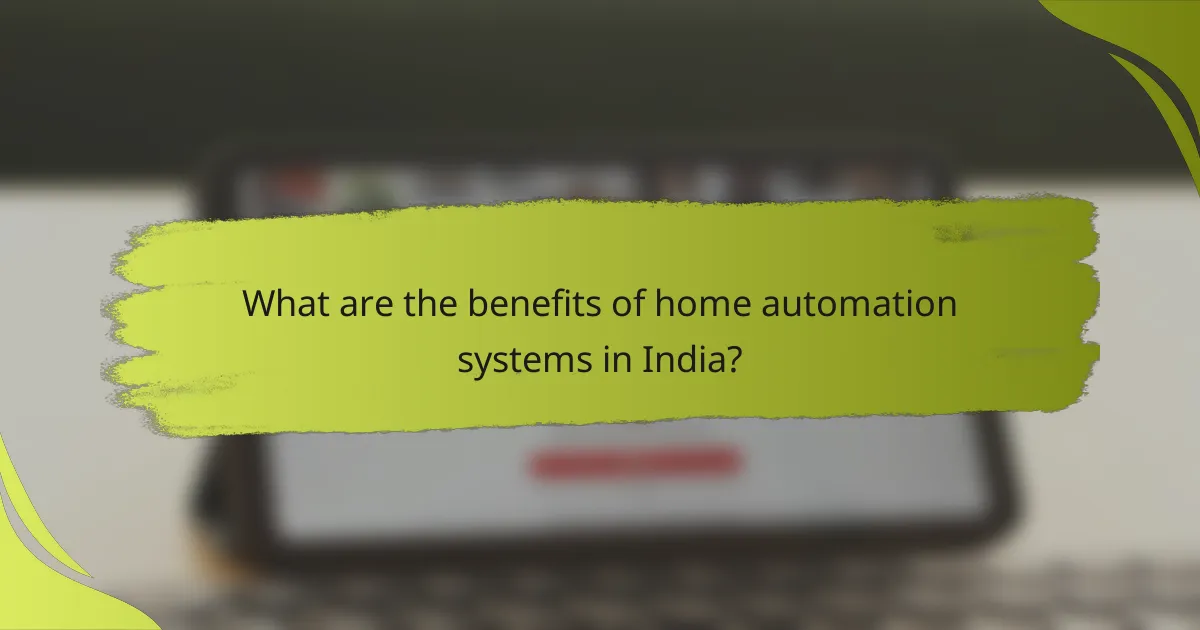
What are the benefits of home automation systems in India?
Home automation systems in India offer numerous benefits, including enhanced energy efficiency, improved security, and increased convenience. These systems allow homeowners to control various aspects of their homes remotely, leading to significant savings and a more comfortable living environment.
Energy efficiency improvements
Home automation systems can significantly enhance energy efficiency by optimizing the use of appliances and lighting. Smart thermostats, for example, adjust heating and cooling based on occupancy patterns, which can lead to savings of around 20-30% on energy bills.
Additionally, automated lighting systems can turn off lights in unoccupied rooms, further reducing energy consumption. Homeowners can monitor their energy usage through apps, allowing them to make informed decisions about their consumption habits.
Enhanced security features
Security is a major advantage of home automation systems, which can include smart locks, surveillance cameras, and motion sensors. These features allow homeowners to monitor their property in real-time and receive alerts for any suspicious activity.
For instance, smart doorbells with video capabilities enable homeowners to see who is at their door, even when they are not at home. This level of control and awareness can deter potential intruders and provide peace of mind.
Convenience and remote access
Home automation systems provide unparalleled convenience by allowing homeowners to control devices from anywhere using their smartphones. This remote access means you can adjust your home’s settings whether you are at work, on vacation, or simply in another room.
For example, you can preheat your oven while on your way home or turn off appliances that you may have forgotten. This flexibility not only saves time but also enhances the overall living experience.
Increased property value
Investing in home automation can increase property value, making homes more attractive to potential buyers. Features like smart lighting, security systems, and energy-efficient appliances are increasingly sought after in the real estate market.
Homes equipped with advanced automation technologies can command higher prices, as buyers recognize the long-term savings and convenience these systems provide. This trend is particularly relevant in urban areas of India, where tech-savvy buyers are on the rise.
Personalized user experiences
Home automation systems can be tailored to meet the specific needs and preferences of each user. For instance, smart home assistants can learn routines and adjust settings accordingly, creating a personalized environment.
Users can set up different profiles for family members, allowing for customized lighting, temperature, and entertainment options. This level of personalization enhances comfort and satisfaction, making daily life more enjoyable.
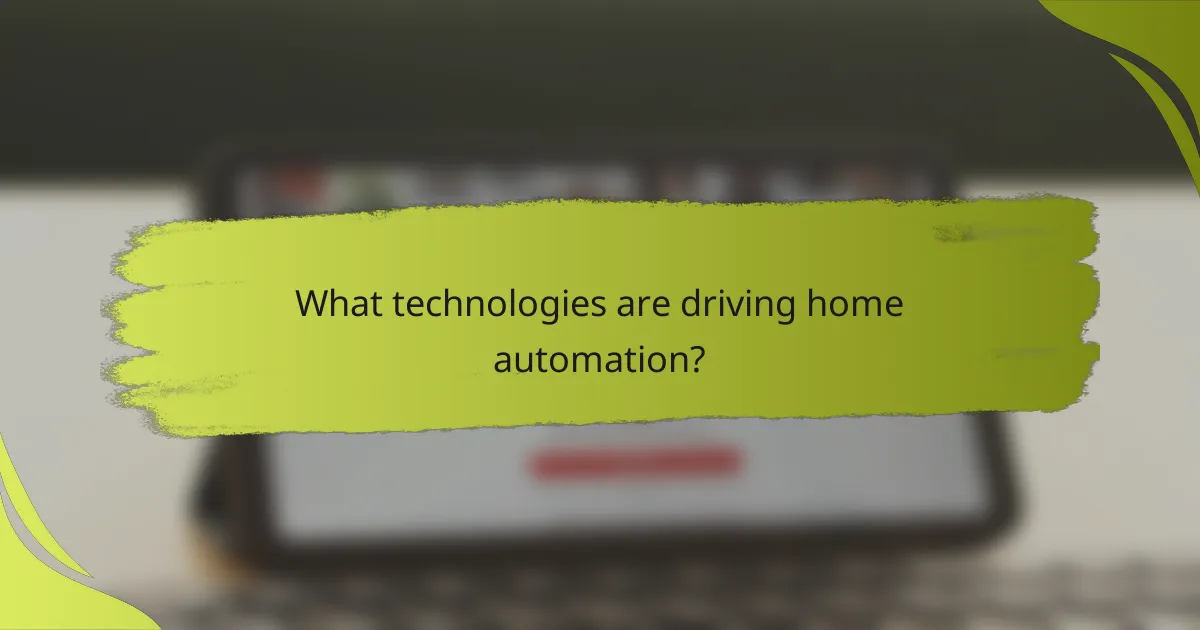
What technologies are driving home automation?
Home automation is primarily driven by advancements in the Internet of Things (IoT), artificial intelligence (AI), smart sensors, and voice control systems. These technologies enhance connectivity, intelligence, and user interaction, making homes more efficient and user-friendly.
Internet of Things (IoT)
The Internet of Things (IoT) connects various devices and systems within a home, allowing them to communicate and work together. This connectivity enables homeowners to control appliances, lighting, heating, and security systems remotely through smartphones or computers.
IoT devices often use standard protocols like Wi-Fi, Zigbee, or Z-Wave, which facilitate seamless integration. When selecting IoT products, consider compatibility with existing systems and the potential for future upgrades.
Artificial Intelligence (AI)
Artificial intelligence enhances home automation by enabling devices to learn user preferences and automate tasks accordingly. AI algorithms analyze data from user interactions and environmental sensors to optimize energy use and improve comfort.
For example, smart thermostats can adjust heating and cooling based on occupancy patterns, potentially saving homeowners significant energy costs. When implementing AI, ensure that privacy considerations are addressed, as data collection is often necessary for effective functionality.
Smart sensors and devices
Smart sensors and devices play a crucial role in home automation by detecting changes in the environment and responding accordingly. These can include motion sensors, temperature sensors, and smart cameras, which provide real-time information and alerts to homeowners.
When choosing smart devices, look for those that offer reliable performance and easy integration with your existing home automation system. Regularly updating device firmware can enhance security and functionality.
Voice control systems
Voice control systems allow users to interact with their home automation systems using natural language commands. Devices like Amazon Alexa, Google Assistant, and Apple HomeKit enable hands-free control of various smart devices, making home management more convenient.
To maximize the effectiveness of voice control, ensure that your devices are compatible with the chosen voice assistant and consider the layout of your home to optimize microphone placement. Be aware of privacy settings, as voice-activated systems may record conversations for improved accuracy.
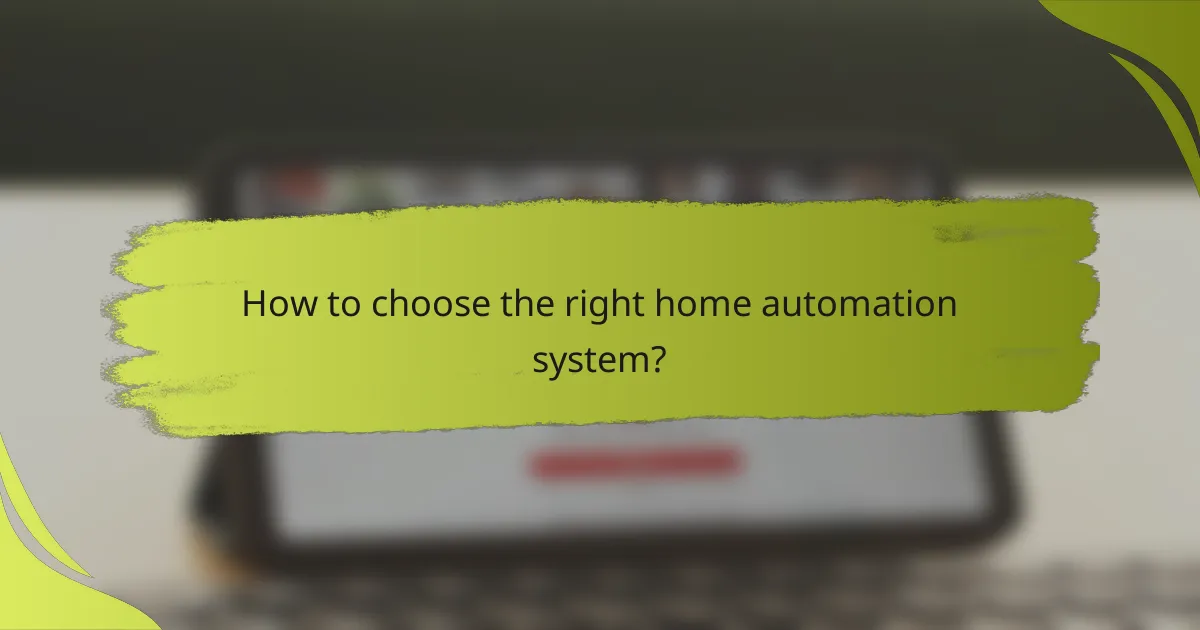
How to choose the right home automation system?
Choosing the right home automation system involves assessing compatibility with your existing devices, evaluating user interface and ease of use, considering scalability for future upgrades, and analyzing customer support and warranty options. A well-selected system can enhance convenience, security, and energy efficiency in your home.
Assessing compatibility with existing devices
Compatibility is crucial when selecting a home automation system. Ensure that the system can seamlessly integrate with your current devices, such as smart lights, thermostats, and security cameras. Check for compatibility with popular standards like Zigbee, Z-Wave, or Wi-Fi.
Before purchasing, review the manufacturer’s specifications and user reviews to confirm that your existing devices will work with the new system. This step can save you from investing in hardware that may not function together.
Evaluating user interface and ease of use
A user-friendly interface is essential for a positive experience with your home automation system. Look for systems that offer intuitive mobile apps or web interfaces, allowing you to control devices easily from anywhere. Consider systems that provide voice control options for added convenience.
Test the system’s interface if possible, as ease of use can significantly affect your satisfaction. A complicated setup or confusing controls can lead to frustration and underutilization of the system’s features.
Considering scalability and future upgrades
Scalability is an important factor when choosing a home automation system. Opt for systems that allow you to add new devices over time without requiring a complete overhaul. This flexibility is particularly valuable as technology evolves and new smart devices enter the market.
Check if the system supports firmware updates or new integrations, ensuring it remains relevant and functional as your needs change. Investing in a scalable system can save you money and effort in the long run.
Analyzing customer support and warranty options
Robust customer support and warranty options can significantly impact your experience with a home automation system. Look for manufacturers that offer comprehensive support, including online resources, live chat, or phone assistance. Good support can help you troubleshoot issues quickly.
Additionally, review the warranty terms to understand what is covered and for how long. A solid warranty can provide peace of mind, protecting your investment against potential defects or failures.
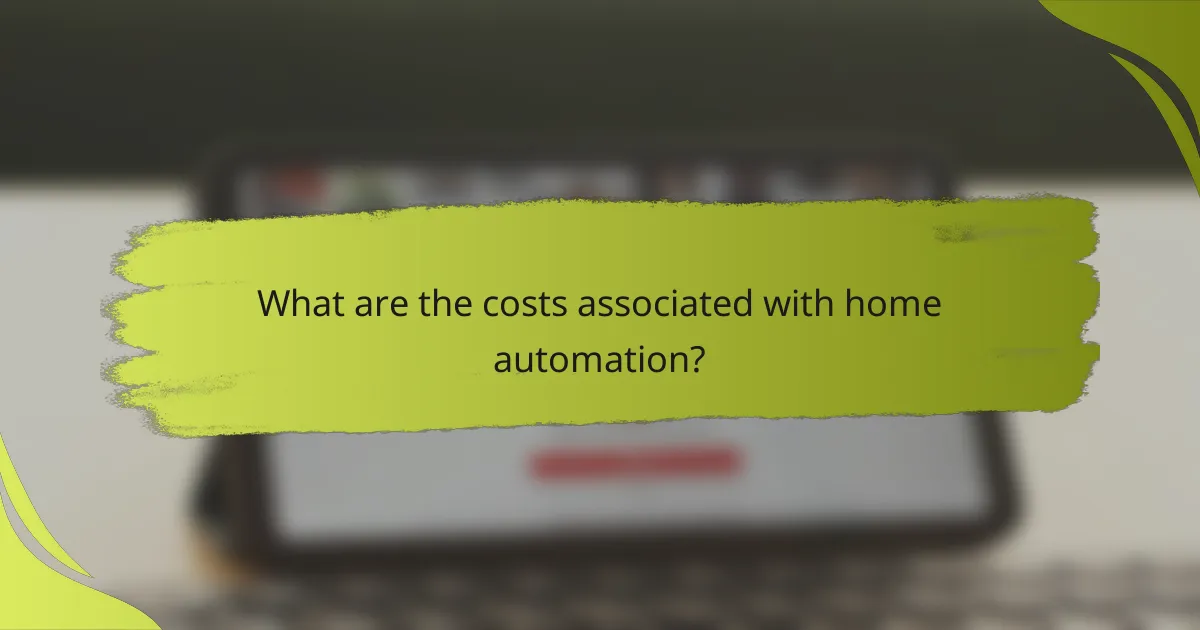
What are the costs associated with home automation?
The costs associated with home automation can vary widely based on the complexity of the system and the specific devices chosen. Homeowners should consider initial setup costs, ongoing maintenance expenses, the cost of smart devices, and potential savings on utility bills when evaluating their investment.
Initial setup costs
Initial setup costs for home automation systems can range from a few hundred to several thousand dollars. Factors influencing these costs include the type of system (DIY vs. professional installation), the number of devices, and the complexity of the integration. For instance, a basic DIY setup might cost around 300-500 USD, while a fully integrated professional system could exceed 5,000 USD.
Homeowners should assess their needs and budget before deciding on the level of automation to implement. Gathering quotes from multiple service providers can help in making an informed decision.
Ongoing maintenance expenses
Ongoing maintenance expenses for home automation systems typically include software updates, device replacements, and potential service fees. These costs can range from 50 to 200 USD annually, depending on the system’s complexity and the number of devices in use.
Regular maintenance is essential to ensure optimal performance and security. Homeowners should factor these costs into their long-term budget when considering a home automation system.
Cost of smart devices and equipment
The cost of smart devices and equipment can vary significantly based on brand, functionality, and compatibility. Basic smart bulbs may cost around 10-20 USD each, while more advanced devices like smart thermostats or security cameras can range from 100 to 300 USD.
When purchasing devices, consider compatibility with existing systems and the potential for future upgrades. Bundling devices from the same manufacturer can often lead to discounts and better integration.
Potential savings on utility bills
Home automation can lead to significant savings on utility bills, particularly through energy-efficient devices. Smart thermostats, for example, can reduce heating and cooling costs by 10-20%, while smart lighting can cut electricity use by up to 30% when programmed effectively.
Homeowners should track their energy usage before and after implementing automation to gauge savings accurately. Additionally, many utility companies offer rebates for energy-efficient upgrades, which can further offset initial costs.
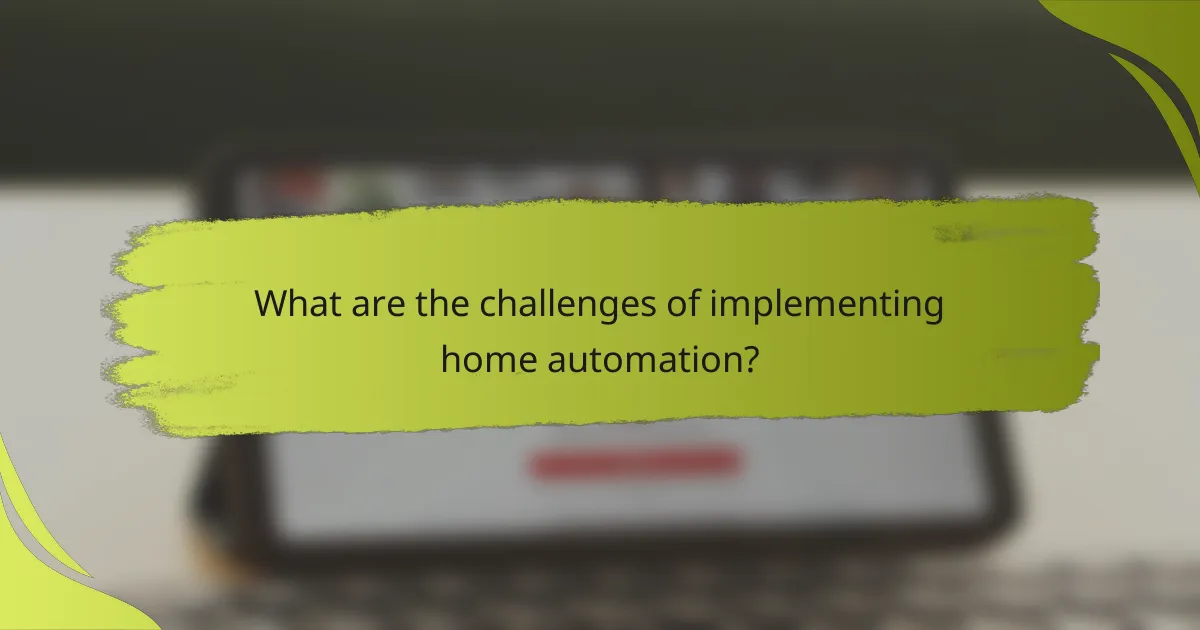
What are the challenges of implementing home automation?
Implementing home automation can be challenging due to technical complexities and concerns about privacy and security. These issues can affect the ease of installation and the overall user experience.
Technical complexity and installation issues
Home automation systems often involve intricate setups that require a good understanding of various technologies. Users may face challenges related to compatibility between devices, network configurations, and the integration of different platforms.
Installation can be a significant hurdle, especially for those without technical expertise. It is advisable to consider hiring professionals for complex systems, as improper installation can lead to malfunctions and increased costs.
Privacy and security concerns
Privacy and security are major concerns for consumers considering home automation. Many devices collect personal data, which can be vulnerable to hacking if not properly secured. Ensuring that devices have strong encryption and regular software updates is essential.
Users should also be aware of the privacy policies of manufacturers and the data they collect. Opting for devices that allow for local control rather than cloud-based services can enhance security and reduce risks associated with data breaches.
